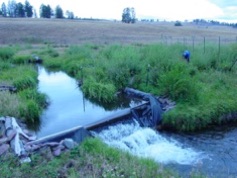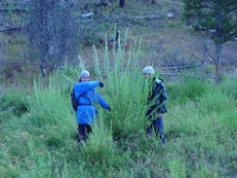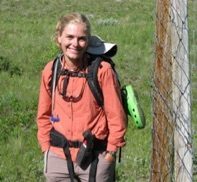
 [/vc_column_text
[/vc_column_text ]
]
The extirpation of wolves from Yellowstone in the early 20th century removed a major predator from the food chain, and apparently allowed elk populations to grow rapidly. National Park Service limited the elk population by shooting elk until 1969 when they adopted “natural regulation” as the philosophy for managing the northern winter range within the park. After 1969 elk populations grew to large numbers with heavy browsing on willows, cottonwood and aspen. In many areas willows were browsed so heavily that beavers could no longer build dams and most small streams have lacked beavers for more than ½ century. Beavers had been at least intermittently present on streams for thousands of years and their dams lead to the accumulation of fine-grained sediment and formed large flat beaver meadows. Beaver abandonment allowed streams to incise these floodplains, and lower the local water table. My research colleague Dr. Tom Hobbs and I began our research on this topic in 2001, with US Geological Survey biologists Dr. Francis Singer (deceased). Masters student Evan Wolf characterized the dynamics of willows on northern range streams and the changes that occurred to landscapes during the 20th century and concluded that due to the channel incision and lack of beavers these stream valleys are now more suitable for supporting upland vegetation. Because the former floodplains are dry, they cannot support willow establishment, and we termed this the Willow-Elk-Grassland state. Simply removing the browsing may not lead to the restoration of the Willow-Beaver-Elk state. We also implemented a factorial experiment to determine whether browsing or the reduction in water availability was the most important factor limiting willow growth. At four sites we had control plots, and plots that were exclosed by fences to eliminate browsing, plots associated with simulated beaver dams that raised the local water table, and plots with both dams and fences. Ph.D. student Danielle Bilyeu (Johnston) worked on this experiment and the response of plant growth and physiological characteristics to the treatments. We have continued the work at the experimental sites and expanded this analysis to the entire northern range with support from a National Science Foundation grant. This program is being conducted by Ph.D. student Kristin Marshall who is working at more than 20 sites on the northern range evaluating the effects of willow herbivory and water availability on willow growth. Kristin’s work is focused on evaluating under what conditions the reintroduction of wolves has allowed willow growth to recover and opens the possibility for the willow-beaver-elk state to recover, or under what circumstances the alternative willow-elk-grassland state is a long-term feature of the landscape. We have recently received funding to continue this work from 2012-2016 through NSF’s Long-term research in Environmental Biology (LTREB) program (proposal below). Graduate student Derek Fedak is working on this program now focusing on herbivore effects, plant ecophysiology and modeling.
2014MarshallCooperHobbsJEcology
BilyeuCooperHobbsEcoApps2008
BilyeuCooperHobbsJApplEco2007
JohnstonCooperHobbs2011
JohnstonCooperHobbsOecologia2007
LTREB_FINAL
MarshallHobbsCooper2013RSPB
WolfCooperHobbsEcApp2007